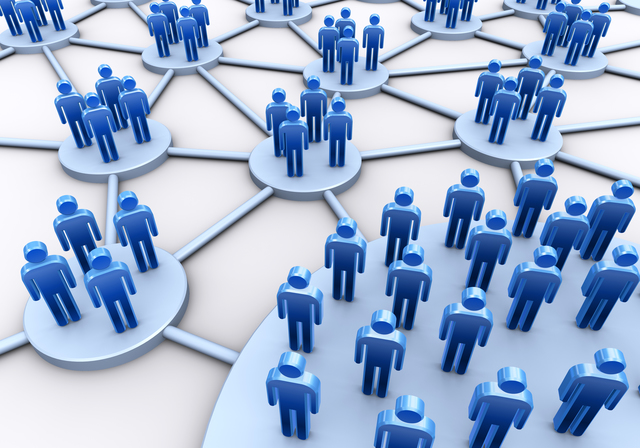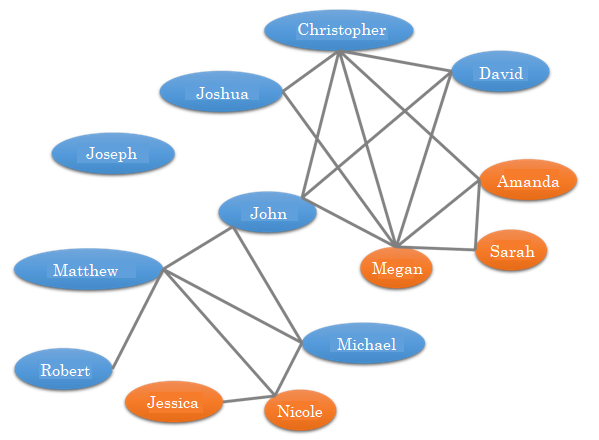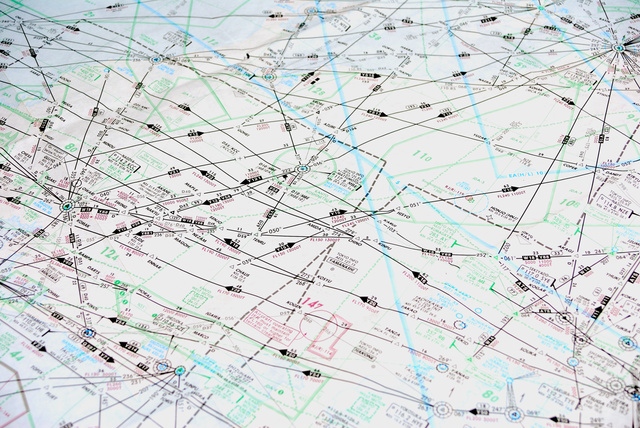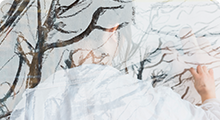Complex systems around us
Connections between people
Society is created as a result of connections between individual people.
Society is created when, among large numbers of people, connections are made between individual people. The schools to which we commute, the club activities in which we take part every day, and the streets on which we dwell are each a type of society, and everybody lives their lives as members of a variety of such societies.
Furthermore, by means of smart phones and personal computers, we can talk to people located far away from us, chat with them using social networks, and obtain information via the Internet, and are thus also connected to different societies to those that physically surround us.

By being connected to a variety of societies, we can obtain and experience information of which we were previously unaware. On the other hand, when these connections become too strong, responding to them becomes onerous and they come to feel burdensome, expressed in symptoms such as loss of sleep. Adlerian psychology posits that all worries are worries about interpersonal relations. What should we do in order to maintain comfortable relationships with society, and with other humans?
Looking at the invisible connections between humans
The connections between humans cannot be seen directly. If we could see them, how would they appear to us?
In order to understand this, we will conduct an experiment. We will conduct a survey of everybody in the class, and get them to write on a piece of paper the names of all the classmates they have talked to in the past week. Next, they write the names of all their classmates in their notebooks and draw lines between those who talked to each other. This results in the appearance of a mesh-like pattern. When we look more closely at this mesh, we see that although there are people who have many connections to others, there are individuals with only a few connections to other people.

Next, we will investigate the number of personal connections it takes to get from one person to a certain other person. Those to whom you are close are connected directly, while those with whom you have little contact need several other people to complete the connection.
If you find the person who is farthest away from you and strike up a conversation with them, you might discover something new that you did not know before.
Is it really true that any two people in the world are connected by an average of just six people?
Once we have understood the connections within the class, next we turn our eyes to the wider world. According to United Nations reports, the population of the planet at the end of 2016 was around 7.3 billion people. In order to connect to an individual somewhere else in the world, such as a celebrity in another country, how many connections to other people would you need to pass through? A thousand? Ten thousand? A million?
The actual number was confirmed in social experiments conducted by Stanley Milgram. Milgram recruited “senders” by means of newspaper advertisements and designated certain people who the sources had never seen nor met as “ultimate recipients.” Senders were asked to put their name, occupation and address on a letter, and send the letter to one of their friends whom they thought might know the ultimate recipient. This process was repeated via connections between mutual friends until the letter arrived at the ultimate recipient.
In the case of those letters that arrived safely at the ultimate recipient, investigations suggested that the average number of people to which the letter passed was 5.5. This is an extraordinarily low number. This concept became famous as the “six degrees of separation” (where “degree” refers to the number of connections), leading to the increasing popularity of the “small world” idea that the world is a surprisingly small place.
In order to understand the “small-world experiment,” we will turn to the Kevin Bacon game (The Oracle of Bacon). Kevin Bacon is a famous American actor who has appeared in many different movies. This game allows you to measure the distance from a given actor to Kevin Bacon by establishing how many other actors must be passed through to complete the connection. *If you enter the name in romanized text, you can also investigate connections to Japanese actors, so by all means give that a try.
Small-world network
What sort of connections underpin the “small-world network” by which any two people in the world are connected by an average of just six friends? (⇒ Reference “Any two people in the world are connected by six people or fewer.)
It was Watts and Strogatz who used mathematics to investigate the “small world” concept. (⇒ Reference “Watts-Strogatz model”.) Let us conduct an experiment.
① The whole class will stand in a circle, with everybody holding the hands of their neighbors.
② Choose one person, and count how many people there are between you and that person.
③ Add up the number for all participants, and calculate the average.
④ Next, choose two people at random and connect them with a string.
⑤ Then, add up the number of people who must be passed through for each connection, for all participants, to derive the average.
When we prepared a few strings in advance and conducted the experiment, we discovered that the average number fell to a surprisingly low figure as the number of strings began to increase. This feature is known as the “small-world network.”
Are close friends unreliable in a pinch?
When they have personal problems or issues on which they need advice, despite being connected to a whole world of people, most individuals probably confide in friends and family in whom they trust. How should we think about the depth (strength or weakness) of such human relationships?
Here is the problem. Who is the most trustworthy person in life? In daily life, it would seem that close friends and parents are the most trustworthy, but in life (taken in the broader sense of the word), there are many situations in which you cannot rely on parents, such as which university to enter, which company to join, who to marry, and when to have children.
Mark Granovetter has conducted research into one of the major life events, namely finding employment. In a paper entitled “The Strength of Weak Ties,” he demonstrated that when looking for employment, it is (somewhat counterintuitively) weak rather than strong social ties that are important. That means that, rather than friends and parents, it may be that the aunts and uncles you meet only a few times a year are more dependable.
This is because the information obtained from close friendships is likely to be similar in kind, whereas weak ties represent a bridge to the outside world, enabling new information to be obtained.
Meeting with good friends is a positive thing, but we recommend that people seek contact with the world outside by talking every now and again with a different set of acquaintances.
Word of mouth and panic
Word of mouth creates many fads and fashions, providing the driving force behind hit movies, and causing videos to go viral around the world. On the other hand, information such as vindictive rumors can also be spread easily and swiftly on the Internet, resulting in social problems such as blogs being overwhelmed.
An example of a social phenomenon caused by personal connections was the Toyokawa Shinkin Bank incident. The incident originated with a high school girl who had received an offer of employment from the Toyokawa Shinkin Bank, and had subsequently been teased by friends who told her that the company was in trouble. In saying that, her friends had actually been referring to the vulnerability of such cooperative financial institutions to bank robbers, but after passing through several people, this metamorphosed into rumors that Toyokawa Shinkin Bank was going bankrupt. The result was a bank run in which 2 billion yen of deposits and savings were withdrawn from the institution.
Casual discussions and murmurs in a network may be misunderstood and disseminated. As the old saying goes, the mouth is the gate of evil, indeed.
Networks all around us
In the summer, screen doors are used to prevent mosquitoes and other insects from entering the house. On misty mornings, if you take a walk in the park you will have no trouble finding spiderwebs covered with dew. Strictly speaking, both screen doors and spiderwebs constitute orderly networks.
It is also quite common to have a contact network in class. In cases where you (A) have a friend (B) who has a friend (C), who is indeed your own friend as well, this interconnected ABC also constitutes a circle of friends. Such connections between people are also referred to as “networks.” Although nobody has that many acquaintances, by passing from friend to friend, it is thought that a route can be traced to any other person in the world. (⇒ Reference “Any two people in the world are connected by an average of six people”)
In major cities such as Tokyo the subway lines are also connected to form a network, and although the complexity can make changing trains confusing, it is very convenient once you have become used to it. Japan Railway lines are also connected from Hokkaido to the mainland of Honshu, and on to Shikoku and Kyushu. The network of routes followed by airplanes also catches the eye, consisting as it does of a trunk network that connects hub airports such as New Chitose, Haneda, Osaka, Fukuoka and Naha, and local routes that connect the hubs to regional airports.

Electricity flows from power stations, to substations and onto individual houses thanks to the electricity network (the power grid). Municipal gas, water and sewage connections are sometimes referred to as lifelines, but these lifelines are also networks” Terrestrial broadcast television also constitutes a network, arranged around key stations. Connections between relay stations for cellular phones are also networks. (⇒ Reference “Barabási-Albert model”)
From this it can be seen that we are surrounded by a huge variety of networks. There are countless numbers of connections that may not appear to be networks at first glance, but that do have the characteristics that would justify referring to them as such. (⇒ Reference “How are networks connected?”)
When you go out for a drive with the family on the weekend and find yourself in a traffic jam, it is because of the road network that you can find a route around it. When there is a suspension or interruption of the railway service, in this too it is the network of lines owned by the various railway companies that allows alternative transportation arrangements to be made.
However, when a transmission line breaks in one location, that shock ripples through the transmission network, and may cause power outages over a wide area. A signal fault at a single location may cause interruptions for many hours on multiple railway lines. Connectedness does not only mean convenience, clearly.
How are networks connected?
If it is on the network, or created in the network, it is all part of the network. As a consequence, we can see a variety of networks all around us.
However, the regular grid of a screen door and an air transport network in which routes radiate from a small number of airports look very different. Which does an expressway network more closely resemble?
We could also take the case of three people, A, B and C. All three may be friends. However, both B and C may like A, but despite (or maybe because of?) that, B and C may not get along (love triangle). More generally, what kind of relationship forms between three people? When the number of people increases, what happens?
There are also various issues to consider in the case of using a railway network. When going from station A to station B, issues to consider include the route with shortest time, the fewest number of changes, and the lowest fare.
Conversely, there is the approach of designing and building the desired network. For example, we want to contact all members of our class while going through the minimum number of people. Or we want to create a road network that allows people to divert around any one location if it becomes impassable, but we also want to control construction costs.
In other words, there are many different approaches to networks. We can more or less see variations in the features, but it should be possible to perceive the differences in a more objective light so as to create a firmer basis for discussion. In order to accurately express the overall characteristics of a specific network, what sort of indicators should we use?
In recent years, the level of interest in networks has risen, and different approaches have been advocated. The broader features of the networks have been understood, labels have been applied, and a variety of indicators have been introduced. (⇒ Reference “Analyzing connections”)
Analyzing connections
In addition to human relationships, many other networks exist around us, such as traffic networks, connections between brain cells, and web-related links. Network analysis is an analytical method that focuses not on the entities in the network (nodes) themselves, but on the connections between these entities (links). Using network analysis, we can compare networks of different types and from different fields, and explain network features and changes in network state.
・[Degree distribution]
Degree distribution refers to the number of connections in respect to the degree of variation, such as whether all people have the same number of connections, or whether a few people have dramatically more connections than others. Tokyo Haneda and Osaka Itami are connected to many other airports, but Rishiri airport in Hokkaido and Miyako airport in Okinawa are each connected to just one other location, so there is significant variation. On the other hand, there is no major variation in the number of roads connecting with an expressway at any given point. This is in part caused by physical restrictions, but is also a device intended to reduce congestion caused by concentrating vehicles in one spot.
・[Average shortest path (average path length)]
This refers to the average for the lowest number of links that will connect two nodes. The idea that any other person in the world can be connected to another through six friends suggests that human relationships form a network in which the average shortest path is very short.
・[Clustering coefficient]
This is the percentage of your friends who are also friends with each other (triangular relationships). With members of the same class, this value tends to be high, because faces match names, but when the school or even year is different, the number of acquaintances falls and so does this value.
・[Centrality]
A value that expresses who is at the center of the network. Which person is the center of the class? It could be the class president, who represents the class itself, but there is also the person who is the most popular in the class. There is a teacher responsible for keeping the class together, but that is not quite the same thing as being at the center of the class. There are also many different definitions of “center,” with degree centrality using the peak to which the largest number of links are connected, and betweenness centrality using the nodes that are most traversed when deriving the average path length (those with the greatest power to connect to others).
・[Community structure]
An area in which links are dense is referred to as a “community.” A single individual may belong to a variety of communities, such as classes, club activities, cram school, and local communities, on top of which there are the communities to be found in social networks. It can be said that human relationships have a community structure. Given this, how is community structure formed? We may find some clues to this in the Schelling segregation model, which investigated the theme of segregation by race, and in Axelrod’s dissemination of culture model.
In network analysis, we primarily compare networks based on three characteristics.
・Scale-free
A characteristic whereby some nodes have a huge number of links, but nearly all nodes have only a few links. As an example of scale-free networks in the real world, let us look at box office revenue for movies. In 2016, the total value of box office revenue for movies was 235.5 billion yen. In first place was an animated feature for adolescents, which was a major hit and generated 23.5 billion yen. In second place was a new instalment of a space opera franchise, with 11.6 billion yen. Given that around 1,000 movies are created every year, a box office of 200 million yen would be about average, but the movie in first place took in 100 times that figure. Furthermore, if we add up the take for the top 10 titles, the total came to 83.8 billion yen, showing that one third of box office revenue came from just 1% of the movies. The property of being scale-free is not limited to movies, but is a characteristic that can be seen in networks such as bestselling books or Internet searches, where the level of interest and attention changes and becomes more concentrated over time. (⇒ Reference “ Barabási-Albert model”)
・Small world
This is a characteristic whereby two arbitrary nodes can be connected by passing through only a small number of other nodes. It is likely that you have from time to time wondered at how small the world is. Using the Kevin Bacon game (The Oracle of Bacon), in which a route can be traced from Kevin Bacon to most actors and actresses via those who have appeared in the same movie as Kevin Bacon, we can get a sense of just how small the world of human relationships is.
This is the characteristic whereby two nodes that link an arbitrary node are also linked to each other. This also indicates the percentage of your friends who are also friends with each other (triangular relationships). It may be that the clustering coefficient of society as a whole is rising, as people use social networks to find old school friends, to register in groups to make new friends, and to expand their opportunities to strike up other relationships. (However, this only applies if the people in question do not forget each other. Prompted by the announcements of the Watts-Strogatz model and the Barabási-Albert model, network analysis research received a great deal of attention as a new paradigm, and led to many new discoveries. During the 20th century, science made progress by means of an approach called reductionism, in which phenomena were broken down into constituent elements to aid understanding. In the 21st century, it may be that science will make its new discoveries using an approach predicated on the existence of networks, that is characterized by trying to understand the relationships between constituent elements (“network science”).



